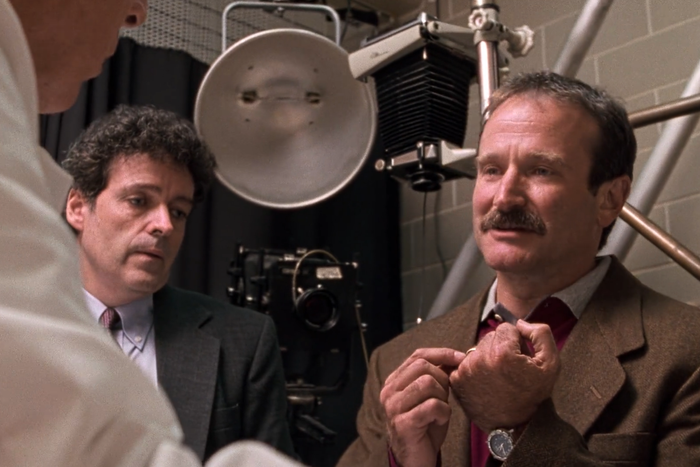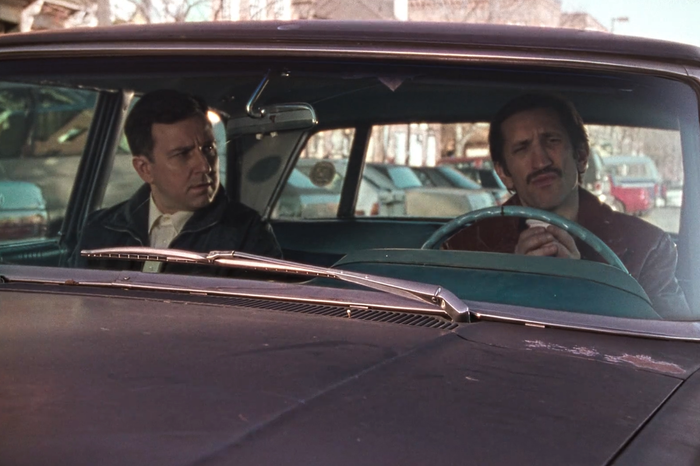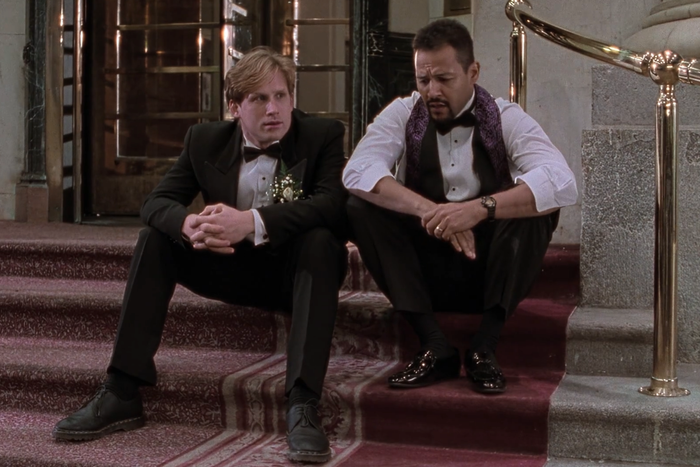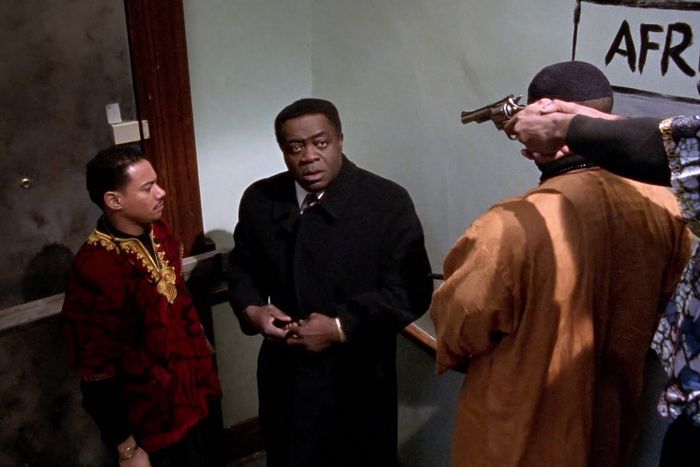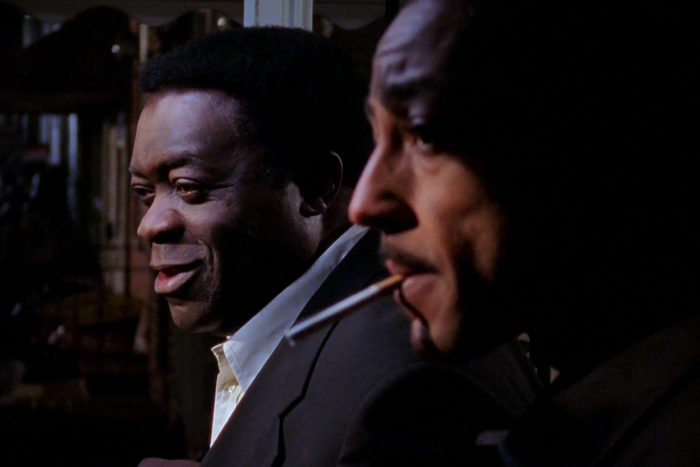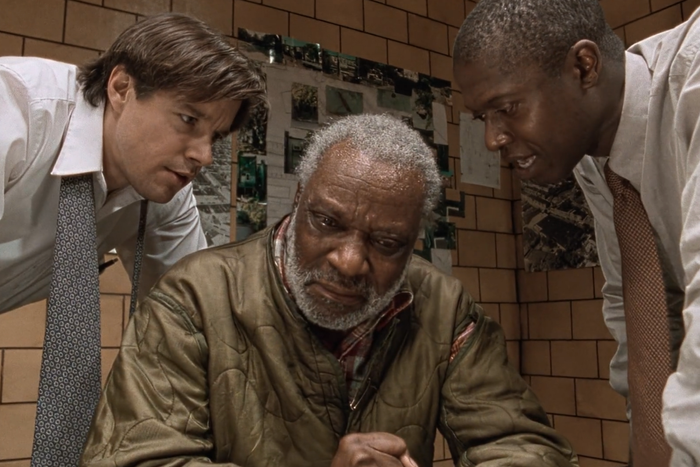
Twenty-five years after Homicide: Life on the Street wrapped its 122-episode run; 24 years after it brought practically the whole gang back together for the made-for-TV film Homicide: The Movie; and many, many impassioned appeals by fans and the series creatives later, one of the most under-appreciated and consistently great police dramas is finally on streaming. Get your Sure, its copaganda, but   talking points ready, because its time to binge.
During its run, Homicide never got the viewership of its NBC sibling Law & Order (although the two had quite a few crossover episodes) or the consistent critical love of its ABC competitor NYPD Blue. But creator Paul AttanasioÔÇÖs series, inspired by David SimonÔÇÖs 1991 nonfiction book Homicide: A Year on the Killing Streets and featuring an exemplary ensemble cast of acting greats (too many of whom have since died), was consistently one of the most risk-taking series operating in this genre. Over seven seasons and a 2000 TV movie, showrunner Tom Fontana and his writing team were as skilled at deep character development as they were at pulling off complicated multi-episode arcs and shocking killer-of-the-week plots. The seriesÔÇÖs score was full of odd clanking and synthy musical cues that well-accompanied each dramatic hour; the editing style was a little frantic and a little visceral; and it often dared to question our assumptive respect for police, poking at their rituals and wondering if the criminal-justice system couldnÔÇÖt do better. That attitude, plus the seriesÔÇÖs downtown-Baltimore setting, SimonÔÇÖs involvement as a writer and producer, and dozens of actors who showed up in both projects made Homicide a clear precursor to the layered, all-the-pieces-matter approach Simon would eventually show off on The Wire.
Homicide admittedly had its weak spots. Black main characters like Meldrick Lewis and Terri Stivers, played by Clark Johnson and Toni Lewis, respectively, deserved more A-stories than they got. Romantic subplots tended to be unbelievable or underdeveloped. ThereÔÇÖs an episode, ÔÇ£Full Moon,ÔÇØ thatÔÇÖs basically just Twin Peaks cosplay. But Homicide was also subject to an inordinate amount of meddling from NBC, which insisted upon certain casting decisions, tried to make the series less dialogue-focused, and recurrently aired episodes out of sequence, an issue that Peacock has corrected by restoring the original viewing order (along with some stunningly crisp, remastered visuals). What the seriesÔÇÖs creative team was able to accomplish despite all this interference is worth celebrating. When all aspects of a Homicide episode really clicked ÔÇö which they did, and often ÔÇö the series had breadth, sprawl, and ambition, and these essential 25 episodes get at what made it so special.
ÔÇ£Gone for GoodeÔÇØ (season one, episode one)
Maybe itÔÇÖs expected, but we have to start with the pilot, directed by executive producer and Baltimore native Barry Levinson. ÔÇ£Gone for GoodeÔÇØ lifts its two main storylines ÔÇö a woman murdering her husbands and other relatives for insurance money, and the senseless murder of a young girl ÔÇö from SimonÔÇÖs book, and weaves them together in a way that introduces us to the personalities within this BCPD unit; some of their domestic hang-ups and professional frictions; and the pressures they face from the highers-up, the community, and the media. The late Andre Braugher was this ensembleÔÇÖs standout actor, and he makes an immediate impression as the haughty, curt, and perhaps overly confident Detective Frank Pembleton, who will butt heads with forced-upon partner Tim Bayliss (Kyle Secor, who really grows into the role) for seasons to come. The murder of 11-year-old Adena Watson, the case Bayliss catches in the episodeÔÇÖs final minutes, is another series-long plot development that will do a lot ÔÇö positively and negatively ÔÇö for Bayliss and PembletonÔÇÖs relationship, especially in the other two season-one episodes on this list.
ÔÇ£Night of the Dead LivingÔÇØ (season one, episode three)
NBC started interfering with Homicide pretty much from the get-go, moving this important character-development episode, intended to air third, to the end of the season over concerns it was too talky for an early-season episode. And sure, thereÔÇÖs a lot of conversation here: The detectives on the night shift come together in the un-air-conditioned squad room during a heat wave, and because they donÔÇÖt get any calls, they just sweat and shoot the shit. But that lack of traditional cop-show action allows the characters to share more of themselves, and subtly explain what motivates them. A subplot about a candle in the squad room thatÔÇÖs being mysteriously lit each night is a lovely grace note, and a final scene with everyone stripping down on the roof so that Yaphet KottoÔÇÖs commander Al ÔÇ£GeeÔÇØ Giardello can spray them with a hose to cool down is a solid and silly bonding moment.
ÔÇ£Three Men and AdenaÔÇØ (season one, episode six)
If youÔÇÖve only heard about one Homicide episode, itÔÇÖs probably this one. Written by Fontana and directed by Martin Campbell of blockbusters GoldenEye, The Mask of Zorro, and Casino Royale, this unbearably tense episode locks Pembleton, Bayliss, and their suspect in Adena WatsonÔÇÖs murder together in the squad unitÔÇÖs interrogation room, nicknamed ÔÇ£the box,ÔÇØ for 12 hours so that the detectives can secure a confession. Visually and tonally, itÔÇÖs the most claustrophobic episode of the series, and the performances from Braugher, Secor, and theater icon Moses Gunn, playing suspected killer Risley Tucker, are across-the-board phenomenal. The Frank/Tim partnership is often turbulent, but here that tension is put to great use as Braugher and Secor switch up good-cop, bad-cop duties and Gunn alternates between dignified and sneering. And itÔÇÖs very in line with the kind of show Homicide is that the episode ends with Frank and Tim swapping opinions about whether this arabber who admits to inappropriate feelings for Adena is actually their guy.
ÔÇ£Black and BlueÔÇØ (season two, episode two)
HomicideÔÇÖs first ÔÇ£cops can really suck both at their jobs and as peopleÔÇØ episode. PembletonÔÇÖs investigation into who killed a drug dealer leads him to question numerous cops, none of whom are cooperative, and he butts heads with Gee, who pressures Pembleton away from their colleagues and toward citizens he suggests may have done the crime instead. Gee is a character weÔÇÖre primed to like because Kotto is so charming, but when he turns on the ÔÇ£chain-of-commandÔÇØ bullshit, ÔÇ£Black and BlueÔÇØ drives home the damaging effects of police┬átribalism. Although the ending swings us back onto GeeÔÇÖs side, ÔÇ£Black and BlueÔÇØ is an early indication that the series wouldnÔÇÖt shy away from questioning whether cops can betray their mission, too.
ÔÇ£Bop GunÔÇØ (season two, episode four)
Homicide had dozens of recognizable character actors, celebrities, and Baltimore figures appear on the show during its run: John Waters, Jay Leno, Bruce Campbell, beloved character actress Margo Martindale, and various eventual The Wire cast members like Jim True-Frost, Peter Gerety, and Richard DeAngelis. But no one made an impact like Robin Williams, who in this episode plays Robert Ellison, a husband, father, and tourist whose wife is murdered in front of him and their children as they explore Baltimore. This episode had a lot of hands on it, with Fontana and recurring collaborators Simon and David Mills handling the story and Stephen Gyllenhaal directing; you might know his son, Jake, who appears in the episode as EllisonÔÇÖs kid. Williams grounds it all with an impressively steely performance that has the man butting heads with jackass Detective Beau Felton (Daniel Baldwin), who boasts about all the overtime heÔÇÖs going to make from this case in front of Ellison, and refusing the apology of his wifeÔÇÖs killer. Season one focused mostly on the homicide unitÔÇÖs members, but ÔÇ£Bop GunÔÇØ shifts focus almost entirely to the victims who survive, demonstrating the seriesÔÇÖs willingness to decenter its primary characters when the narrative demanded it.
ÔÇ£Extreme UnctionÔÇØ (season three, episode three)
BraugherÔÇÖs consistent greatness meant that Pembleton often got the most challenging emotional arcs and moral quandaries, and ÔÇ£Extreme UnctionÔÇØ is perhaps the most important of the series in that regard. PembletonÔÇÖs relationship with Catholicism is strong and true, and this episode blows that all up as Frank questions Annabella Wilgis, a woman with multiple personalities who is suspected of being a serial killer targeting female churchgoers. He slides into flirtation and seduction, a degradation of his interviewing style that demonstrates how desperate he is to prove her guilt and proves to be a major mistake that Wilgis and her lawyer will eventually use against him. ItÔÇÖs rare to see Pembleton genuinely rattled, and Braugher gives the character cracks in his self-assured veneer that help us understand how deeply this case has, and will continue to, cause his crisis of faith.
ÔÇ£CrosettiÔÇØ (season three, episode four)
This oneÔÇÖs a heartbreaker. In the first and second seasons of the series, Jon PolitoÔÇÖs Detective Steve Crosetti was a history buff and a devoted friend, an overprotective father and a dogged investigator, and a loyal partner to Meldrick Lewis, the latter of which made it particularly odd when season three premiered and he was nowhere to be found. The character is mysteriously off-screen for a while, until in ÔÇ£Crosetti,ÔÇØ a reveal: His body is found in the Inner Harbor, and his autopsy reveals enough alcohol and drugs in his system that the medical examiner rules his death a suicide. ItÔÇÖs a jarring character exit that was partially shaped by NBCÔÇÖs pressure to increase viewership and miscommunication between Polito and Fontana about how CrosettiÔÇÖs role would change in season three, and made worse by NBC airing the episode out of order, after another episode had already mentioned CrosettiÔÇÖs death in passing. But the shock value worked as a way to suggest that Crosetti ÔÇö┬áand by extension, all of HomicideÔÇÖs characters ÔÇö was dealing with demons and regrets that might not make it on-screen but that nevertheless affected his decisions, and to create another wedge between the homicide unit and the departmentÔÇÖs administrators, who deny Crosetti a funeral with full honors because he died by suicide. And ÔÇ£CrosettiÔÇØ also finally provided a spotlight for Clark Johnson, who handled all of LewisÔÇÖs conflicting feelings about his partnerÔÇÖs death with relatability and grace.
ÔÇ£The City That BleedsÔÇØ (season three, episode 13)
The beginning of a three-episode mini arc with reverberations throughout the seriesÔÇÖs run, ÔÇ£The City That BleedsÔÇØ is another example of how Homicide could knock viewers out of complacency when it wanted to. As the detectives serve a routine warrant, theyÔÇÖre ambushed, with three shot and in critical condition, one traumatized, the rest of the squad scrambling to find the person responsible, and Gee realizing that he might have made a mistake that led to the snafu. All this danger toward HomicideÔÇÖs main characters could have felt over the top, but this episode and the next two are pacing marvels. They emphasize the very real possibility that any, or all three, of the shot detectives could die, while also conveying the frustration, fear, and fury of everyone else in the homicide unit. Plus, Steve Buscemi plays a real asshole in the second and third episodes of this trio, and thatÔÇÖs always fun.
ÔÇ£The Gas ManÔÇØ (season three, episode 20)
Homicide could be very wacky when it wanted to (see also: season fourÔÇÖs Edgar Allan Poe homage, ÔÇ£HeartbeatÔÇØ), and Levinson returned to direct this wackiest of installments, a Friends of Eddie CoyleÔÇôstyle neo-noir that follows a pair of crummy small-time criminals as one of them aims to get revenge against Pembleton for putting him away years ago. A more extreme version of ÔÇ£Bop GunÔÇØ handing over a ton of screen time to Williams, ÔÇ£The Gas ManÔÇØ lets guest stars Bruno Kirby and Richard Edson run amok, stalking Pembleton, getting involved in a case with a severed head, and yapping wise-guy dialogue back and forth. ItÔÇÖs a weird delight, and it features one of the ugliest, most amazing pieces of ÔÇÖ90s furniture ever put onscreen. YouÔÇÖll know it when you see it.
ÔÇ£Fire, Part 2ÔÇØ (season four, episode two)
Season four begins with BaldwinÔÇÖs Felton and Ned BeattyÔÇÖs Stan Bolander written out of the show, and Reed DiamondÔÇÖs Detective Mike Kellerman, a real mixed bag of a character, taking their place. Clearly intended as a sort of replacement for Felton, Kellerman was introduced as a charming hottie and eventually got into an on-again, off-again relationship with new chief medical examiner Dr. Julianna Cox (Michelle Forbes). As a representative of BaltimoreÔÇÖs white working class (a protoÔÇôNick Sobotka, but with a badge instead of a Local 1514 card), Kellerman also had some not-great racial politics and an increasingly bitter feud with the seriesÔÇÖs most diabolical villain, drug dealer Luther Mahoney (Erik Dellums). He was street-smart but also stupidly impulsive, and the two-part ÔÇ£FireÔÇØ episodes both track his characterÔÇÖs particular set of skills (he was originally with the BCPDÔÇÖs arson unit, and then swayed by Gee to the homicide team) and set up a long-running subplot about whether Kellerman might be dirty, a fascinating question to ponder right off the bat about a new character. ÔÇ£Part 2ÔÇØ gets the essential-episode edge because it provides a glimpse of KellermanÔÇÖs home life, and Diamond gives the character a solid wistfulness in that scene.
ÔÇ£A DollÔÇÖs EyesÔÇØ (season four, episode four)
The less said about ÔÇ£A DollÔÇÖs Eyes,ÔÇØ the better, so you can experience it for yourself. Just know that the plot will rip your heart out, Marcia Gay HardenÔÇÖs guest performance is phenomenal, and the episodeÔÇÖs questions about life, death, and whether the body and soul are separate or intertwined entities will leave you arguing with yourself for a long time.
ÔÇ£The HatÔÇØ (season four, episode 12)
Another goofy, wonderful episode, with Lily Tomlin playing a woman accused of killing her husband who new partners Lewis and Kellerman have to pick up and bring back from Pennsylvania. Tomlin is hilarious playing a faux-genteel version of her typical smart-ass self, and the ease with which she sweet-talks Lewis and Kellerman into doing exactly what she wants makes for one of the most purely comedic episodes of Homicide. ThereÔÇÖs also a solid subplot in Richard BelzerÔÇÖs Detective John Munch butting heads with J. H. Brodie (Max Perlich), the new homicide unit videographer: Munch wants Brodie to lose a videotape that disproves his theory on what happened at a crime scene, Brodie refuses to, and their disagreement highlights the divide between a cop who wants to bend the rules to put a dangerous person away, and a former news cameraman whose journalism background makes him wary of lying. ItÔÇÖs a good contrast with valid arguments on both sides. Oh, and Walt MacPhersonÔÇÖs Detective Roger Gaffney ÔÇö one of the most reprehensible characters on this show ÔÇö secures a major promotion that puts him partially in charge of the homicide unit, and his petty villainy will be a recurring issue.
ÔÇ£The Damage DoneÔÇØ (season four, episode 19)
Remember Luther Mahoney, the drug dealer loathed by Kellerman? HeÔÇÖs HomicideÔÇÖs version of The WireÔÇÖs Avon Barksdale, Stringer Bell, or Marlo Stanfield, a kingpin who basically every cop and Baltimore citizen in the know are aware of but can do pretty much nothing about, and heÔÇÖs a major figure in the seriesÔÇÖs fourth and fifth seasons. ÔÇ£The Damage DoneÔÇØ follows Lewis and Kellerman as they get on MahoneyÔÇÖs trail, start piecing together how he shields himself with philanthropy, and argue about the impact drugs have had on the cityÔÇÖs Black community; thatÔÇÖs all good stuff. But the primary reason this episode is an essential pick is for its final scene, which cements Mahoney as one sadistic dude.
ÔÇ£The WeddingÔÇØ (season four, episode 20)
Lewis unfortunately doesnÔÇÖt get a ton of episodes that focus specifically on his personal life or his thoughts about the job, but ÔÇ£The WeddingÔÇØ is a series highlight because it finally gives Johnson a chance to dig into those aspects of the character. After Lewis surprises all his colleagues at work by inviting them to his wedding that night ÔÇö and giving them each tasks at the reception ÔÇö Johnson cycles through all the characterÔÇÖs excitement and anxiety, and itÔÇÖs probably the most genuine and blissful Lewis has ever been. Two other subplots of note: ThereÔÇÖs enjoyable silliness in Melissa Leo, who plays no-nonsense Detective Kay Howard, also playing the characterÔÇÖs flighty, flirtatious sister Carrie, whom Bayliss and Kellerman both make moves on. And on the other side of the spectrum is GeeÔÇÖs role in an officer-involved shooting, a tragedy that weighs heavily on his conscience (and tarnishes his reputation) through Homicide: The Movie.
ÔÇ£Work RelatedÔÇØ (season four, episode 22)
The Pembleton-has-a-stroke episode, inspired by Braugher going to Fontana after the seriesÔÇÖs third season and telling the showrunner he was ÔÇ£no longer satisfied or challengedÔÇØ by the character and needed a change. ÔÇ£Work RelatedÔÇØ is a major turning point not just for Braugher (who completely physically transforms in the upcoming fifth season), but for PembletonÔÇÖs overall arc, his relationship with his wife, and his partnership with Bayliss, and that all starts with this episodeÔÇÖs final act. It is incredibly difficult to watch ÔÇö in no small part because of how Secor sells BaylissÔÇÖs horrified reaction to his best friendÔÇÖs medical emergency ÔÇö but when Pembleton asks for a cigarette after a seizure, at least youÔÇÖll get a laugh.
ÔÇ£Bad MedicineÔÇØ (season five, episode four)
ÔÇ£Bad MedicineÔÇØ is the Homicide episode that feels most like a rough draft of what Simon would do on The Wire, and as such, is one of the seriesÔÇÖs best depictions of the cruelty and carelessness with which people in power will act to maintain it. With a bad package killing heroin addicts around the city and the dealer found murdered, Narcotics Detective Terri Stivers (Toni Lewis) joins the team to both track down the poisoned drugs and find a way to finally make a body hang on Mahoney. In the storyÔÇÖs B-plot, Kellerman learns heÔÇÖs under investigation by the U.S. government; thereÔÇÖs a probe into the behavior of his former arson unit, and KellermanÔÇÖs been accused of accepting bribes. Both Mahoney and KellermanÔÇÖs colleagues will say whatever, and betray whomever, to keep themselves out of trouble, and Kellerman, Lewis, and Stivers are left grappling with the fallout. Homicide ties these three characters together for the next couple seasons, and all the eventual strife between them starts out in this episode.
ÔÇ£The DocumentaryÔÇØ (season five, episode 11)
Structurally, yes, ÔÇ£The DocumentaryÔÇØ is a clip show. That much-dreaded format can feel like filler, a way for series to pad its episode orders back when 20-plus-installment seasons used to be the norm. (Oh, what blessed halcyon days.) ÔÇ£The Documentary,ÔÇØ in which Brodie presents the detectives with a documentary about the unit heÔÇÖs been working on in secret, isnÔÇÖt skippable, though; itÔÇÖs a must-watch episode packed with character development and meta references to criticism about the series. Homicide rarely broke the fourth wall, but ÔÇ£The DocumentaryÔÇØ does so with a punk-rock attitude that felt like the series refusing to back down and letting us in on the joke.
ÔÇ£BetrayalÔÇØ (season five, episode 12)
Braugher was always the most heralded member of HomicideÔÇÖs cast, but in a lot of ways, Pembleton stays the same over time. He struggles with his faith and his physical capabilities after his stroke, but he never doubts his love for his wife, his own moral code, or his abilities in the box. All of that certainty needs a partner character who is more in flux for a classic opposites-attract balance, and SecorÔÇÖs Bayliss served that role. He was initially uptight, a little homophobic, and loyal to his family to the point of defending his cousin even after the manÔÇÖs racist tendencies led him to kill a Turkish foreign-exchange student. Bayliss changed a lot over time (his sexuality became more fluid, he grew interested in Buddhism), and in this episode, we get a glimpse into the hows and whys of that transformation. What if something so awful happened in BaylissÔÇÖs childhood that his repression of it shaped him as an adult, and what if that thing ÔÇö once Bayliss is finally ready to reckon with it ÔÇö pushes him away from the only detective partner heÔÇÖs ever had? ÔÇ£BetrayalÔÇØ is essentially a breakup episode for the most important couple on this show, and itÔÇÖs an acting standout for Secor, who also directed three episodes of the series. (His castmate Johnson directed five, including this episode.)
ÔÇ£DeceptionÔÇØ (season five, episode 19)
Oh, an episode about police officers breaking bad, and then engaging in a massive cover-up to save their own asses? Yeah, thatÔÇÖs gonna be on this list! ItÔÇÖs not just that ÔÇ£Bad MedicineÔÇØ so effectively suggests maybe policing isnÔÇÖt a job someone should do long term, especially if that individualÔÇÖs personality tends toward self-aggrandizing, but also that the conflict and stakes raised by that suggestion feel right for these characters as we know them. The ending is a shock, but it doesnÔÇÖt come out of nowhere. LewisÔÇÖs simmering temper and growing dissatisfaction with getting outplayed by the criminals theyÔÇÖre chasing, KellermanÔÇÖs haughty certainty of his own superiority over not just the bad guys, but his colleagues, too, and StiversÔÇÖs discomfort with how the homicide unit operates are all in line with what weÔÇÖve seen from them before. How these three do, and donÔÇÖt, see eye to eye about their shared lie reflects the way one institutionÔÇÖs mission can be corrupted and misinterpreted, an issue that will come up with more and more regularity as this conflict reaches a breaking point down the line.
ÔÇ£NarcissusÔÇØ (season five, episode 20)
Kotto wrote three episodes of Homicide, of which ÔÇ£NarcissusÔÇØ was the first and most subversive. Both its plot and its unapologetic tone reflect KottoÔÇÖs own Black activism and interest in taking roles that Black people would relate to and that would make white people uncomfortable. ÔÇ£NarcissusÔÇØ is mostly a stakeout-and-negotiation episode, with a murder suspect taking shelter in the headquarters of BaltimoreÔÇÖs African Revival Movement organization and the police brass bristling at the fact that the movement is led by a former officer who was wrongly pushed out of the department. Burundi Robinson (Roger Robinson) is partially motivated by revenge, but also by a legitimate belief that Black people in this country will never get a fair shake unless they take it for themselves. GeeÔÇÖs sympathy for that idea makes him hesitate storming the building, and that disconnect leads to one of the seriesÔÇÖs most upsetting ÔÇö and best ÔÇö endings, which emphasizes how Robinson might have been right all along.
ÔÇ£The SubwayÔÇØ (season six, episode four)
The closest Homicide has ever gotten to feeling like Law & Order, and thatÔÇÖs saying a lot, since the series shared three pairs of crossover episodes and crafted a history between Munch and Jerry OrbachÔÇÖs Detective Lennie Briscoe. What ÔÇ£The SubwayÔÇØ captures so well about Law & Order is its sense of randomness ÔÇö how sometimes crime just happens to people in the wrong place at the wrong time, with nothing they could have done to avoid it. There arenÔÇÖt always personal motives or nefarious reasons for violence or death; life can be more arbitrary than that. Vincent DÔÇÖOnofrio stars as a Baltimore subway rider who ends up trapped between a train and the platform it was pulling into, and his character is a horrible, snarling bully who makes everyone who tries to help him miserable. But does that mean he doesnÔÇÖt deserve their assistance in figuring out who pushed him? ItÔÇÖs a straightforward ethical question that makes for a thrilling, troubling episode. Two other fun Law & OrderÔÇôadjacent tidbits here: Belzer took the Munch character to Law & Order: Special Victims Unit, where he appeared in 16 seasons, and DÔÇÖOnofrio starred on Law & Order: Criminal Intent for ten seasons. Once you were in the NBC crime-drama casting pool, you stayed in the NBC crime-drama casting pool.
ÔÇ£Fallen Heroes, Part 1ÔÇØ (season six, episode 22)
A number of heralded directors passed through Homicide ÔÇö including Levinson, Matt Reeves, and Alan Taylor ÔÇö and Kathryn Bigelow was often tapped when the series had an action banger. The last few minutes of ÔÇ£Fallen Heroes, Part 1,ÔÇØ absolutely qualify; the episode is almost an inverse of ÔÇ£The City That BleedsÔÇØ in that a series of sloppy mistakes by the detectives lead to a nightmarishly violent sequence that shook up what Homicide was willing to put its characters (and viewers) through. This was the first installment of a two-parter that closed out the sixth season and included BraugherÔÇÖs final appearance on the series proper; to say more would be to spoil too much, but underestimate Mekhi Phifer at your own peril.
ÔÇ£Shades of GrayÔÇØ (season seven, episode ten)
Another Lewis-focused episode, with the characterÔÇÖs best and worst qualities on full display as he leads the investigation into two murders that occur after a white bus driver hits a pregnant Black woman in the city. The good: Lewis knows his city, and he knows how the post-riot crime scene looks might not suggest what actually happened. The bad: Lewis has always been a bit of a misogynist, and here we see how his prejudices about womenÔÇÖs physical ability to serve as cops calcify after his new partner Rene Sheppard (Michael Michele) gets jumped and they both almost get killed. That sexism isnÔÇÖt great, but Johnson makes LewisÔÇÖs struggle to trust Sheppard again believable as the two tiptoe around each other for the rest of the season. And the scene where Lewis loses his temper in a dance club in an attempt to get SheppardÔÇÖs stolen gun back, and flows through frustration, shame, and self-disgust during his appeal, is against-type effective, proving that Johnson was always capable of more than being just the seriesÔÇÖs resident cool guy. (Something The Wire confirmed by casting Johnson as the similar world-weary and streetwise Baltimore Sun city editor Gus Haynes.)
ÔÇ£Forgive Us Our TrespassesÔÇØ (season seven, episode 22)
HomicideÔÇÖs final season made a lot of changes: Giancarlo Esposito joined the cast as GeeÔÇÖs FBI agent son, Mike; Kellerman became a private investigator after leaving the force; medical examiner Dr. Julianna Cox abruptly left town. Not all of them worked; particularly trying was the utterly lacking-in-heat illicit relationship between detective colleagues Paul Falsone (Jon Seda) and Laura Ballard (Callie Thorne). But to the seriesÔÇÖs credit, when it came time to wrap it all up, Homicide knew which simmering subplots and tensions deserved the most attention, like BaylissÔÇÖs growing recklessness without Pembleton by his side and GeeÔÇÖs ambition potentially taking him away from the unit. Most poignant is how ÔÇ£Forgive Us Our TrespassesÔÇØ ends by paying homage to how the series began, with Lewis repeating to Sheppard a line from a conversation between him and Crosetti in ÔÇ£Gone for GoodeÔÇØ: ÔÇ£ThatÔÇÖs whatÔÇÖs wrong with this job. It ainÔÇÖt got nothing to do with life.ÔÇØ Literal, figurative, and just insightful enough to demonstrate what made Homicide so good.
Homicide: The Movie
Over HomicideÔÇÖs seven seasons, actors came and went on good and bad terms, but thereÔÇÖs a really lovely, completist quality to how pretty much everyone came back for Homicide: The Movie, which aired a year or so after the series wrapped. Directed by Jean de Segonzac, who was responsible for shaping the seriesÔÇÖs cinema-v├®rit├®-influenced visual style, and penned by Fontana and series writers Eric Overmyer and James Yoshimura, Homicide: The Movie feels simultaneously seamless and experimental. Nearly all the charactersÔÇÖ personalities feel exactly in line with who we know them to be, from GeeÔÇÖs likable braggadocio to Pembleton and BaylissÔÇÖs half-bickering, half-vulnerable relationship to KellermanÔÇÖs shrugging disinterest in following protocol. The two primary action scenes are cacophonous and unexpected, exactly how Homicide always did it. But there are surreal sequences here, too, unusual staging choices and dream-logic moments that give the whole thing an appropriately melancholy and sentimental air that ÔÇ£Forgive Us Our TrespassesÔÇØ ÔÇö while a very good episode ÔÇö lacked. Given how many actors from this ensemble have since passed away in the 24 years since Homicide: The Movie aired, that vibe feels right.



